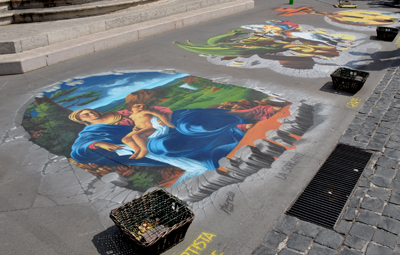if loreto, then the reformation
August 13, 2012
10th entry – le marche 2012
Today we drove across Le Marche and then south to Loreto, the city of the holy house. (Supposedly, angels carried the house that Mary lived in from Palestine and deposited in Loreto.)
The Basilica is this huge structure with a square in front. The square is surrounded by porticos. One side is the Apostolic Palace – Church offices on the piazza level, Church residences on the second floor. These are grand residences that are now a museum and it’s clear that the Church officials who lived in these rooms were nobility. There is no poverty here.
A young man was painting these chalk-drawings on the floor of the piazza. He had three baskets for donations under each. (Hey, if Mother Church can collect from all the pilgrims that flock here, why can’t he?)
Loreto attempts to do the same thing that Assisi does – create a destination for pilgrims. The difference between the two locations stares you in the face. Where Assisi has historical significance – the birth place of Francesco di Bernardone – and artistic significance – Giotto’s famous frescoes line the walls of the Cathedral; Loreto is fictional Catholicism. The Church made up this place.
Inside of the Cathedral, behind the main altar is this four-sided, open box of marble, beautifully decorated with carvings and reliefs. This external box is amazing in its complexity and artistry. The inside is lined with rock – supposedly from Palestine – but open to the dome. The ceiling is early Signorelli. In Orvieto, we see the mature master depicting the Apocalypse with its avenging angels assigning the locals their place in a tableau of eternal-rest. (In Loreto the avenging angel is in grey armor. In Orvieto he’s gloriously naked. In Loreto he’s a two meters tall controller, in Orvieto he’s a 10 meters tall beautiful avenger, the central figure in the tableau.)

It’s hard to walk through this box and think of the young Palestinian woman who was supposed to have lived here. There are frescoes on the stone walls, frescoes of angels. (Judaism does not depict heavenly creatures. The frescoes are Italian in execution and culture.) There is a marble altar in front of the back wall. There are gold candle holders on the marble altar. And the stones look like they could have come from any quarry in the area. And there are small niches with other gold ornaments. It’s absolutely clear that this whole complex was created and given meaning by some Church official. There is no theological, archeological, or religious base for anything here. It was created as a place that would attract pilgrims, that would attract pilgrim money. It is extremely successful. Four million pilgrims a year journey to Loreto.
I always understood Martin Luther on an intellectual level. After being in Loreto, I understand him on a gut level. Seeing the Disneyland house and realizing it’s a for-profit operation, makes Martin Luther a visionary, a prophet that the Catholic Church could not accept or learn from. And like all true prophets, he was persecuted and ostracized.
Oh, BTW, the Madonna of Loreto is a black Madonna.